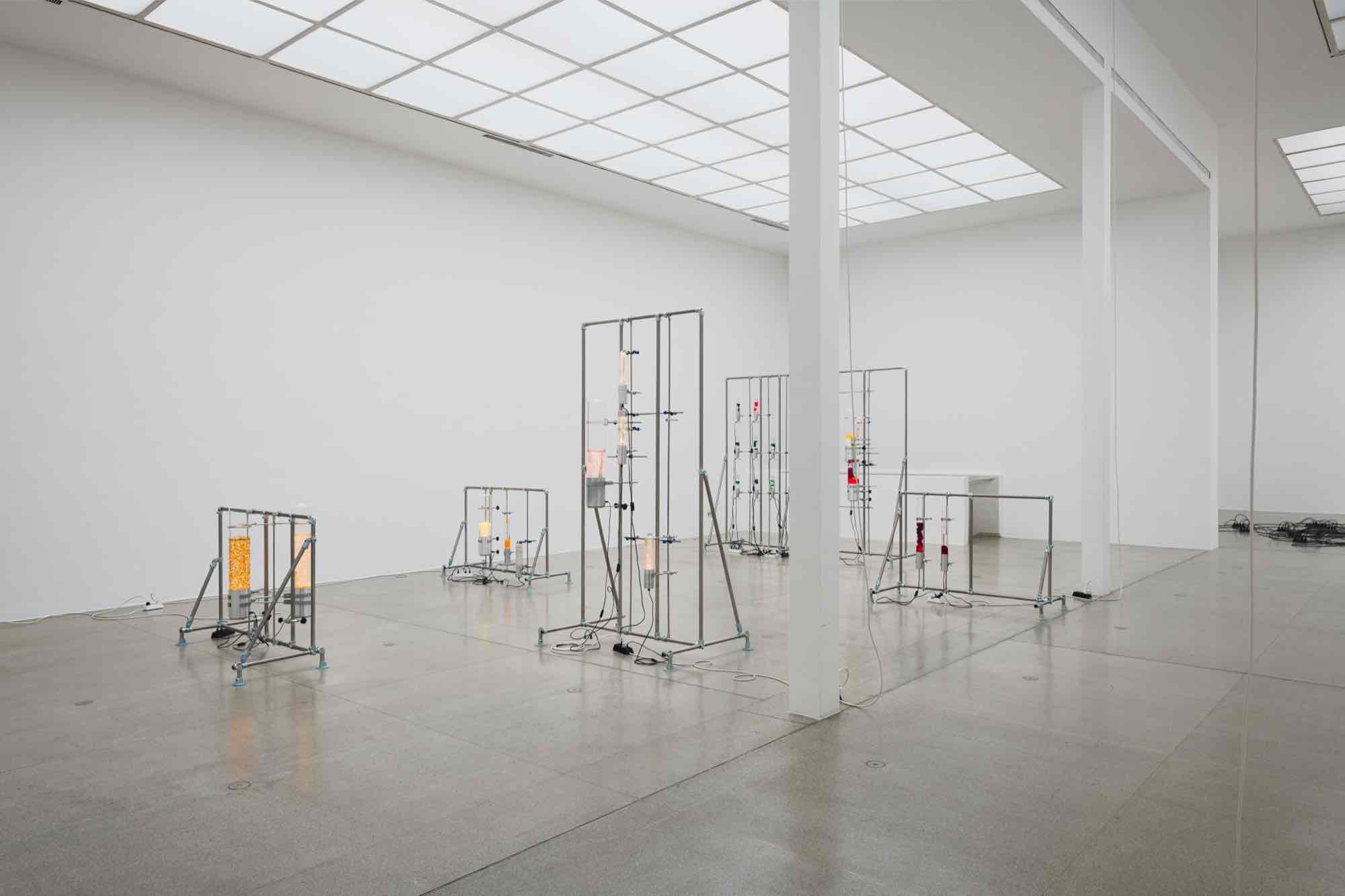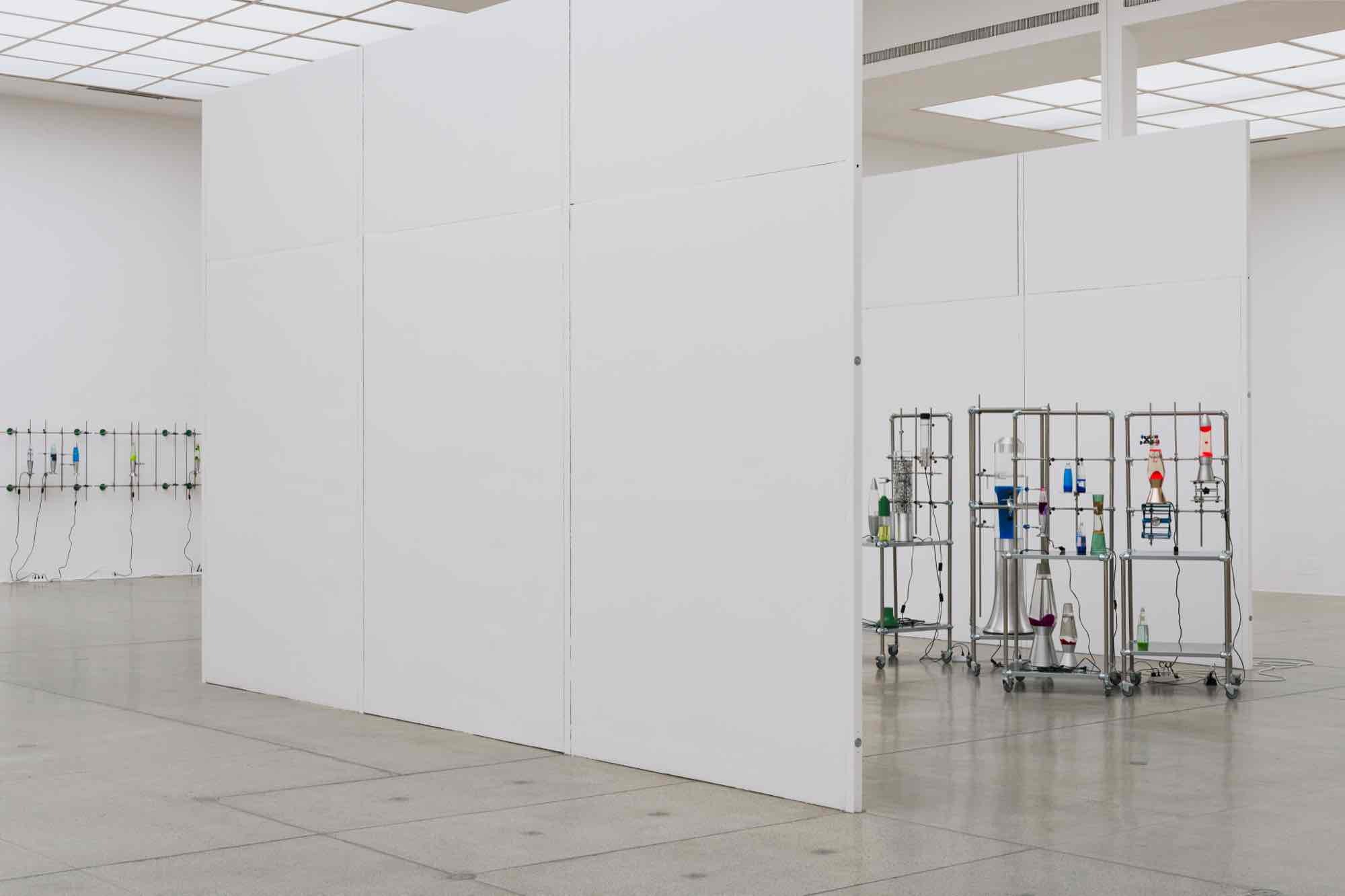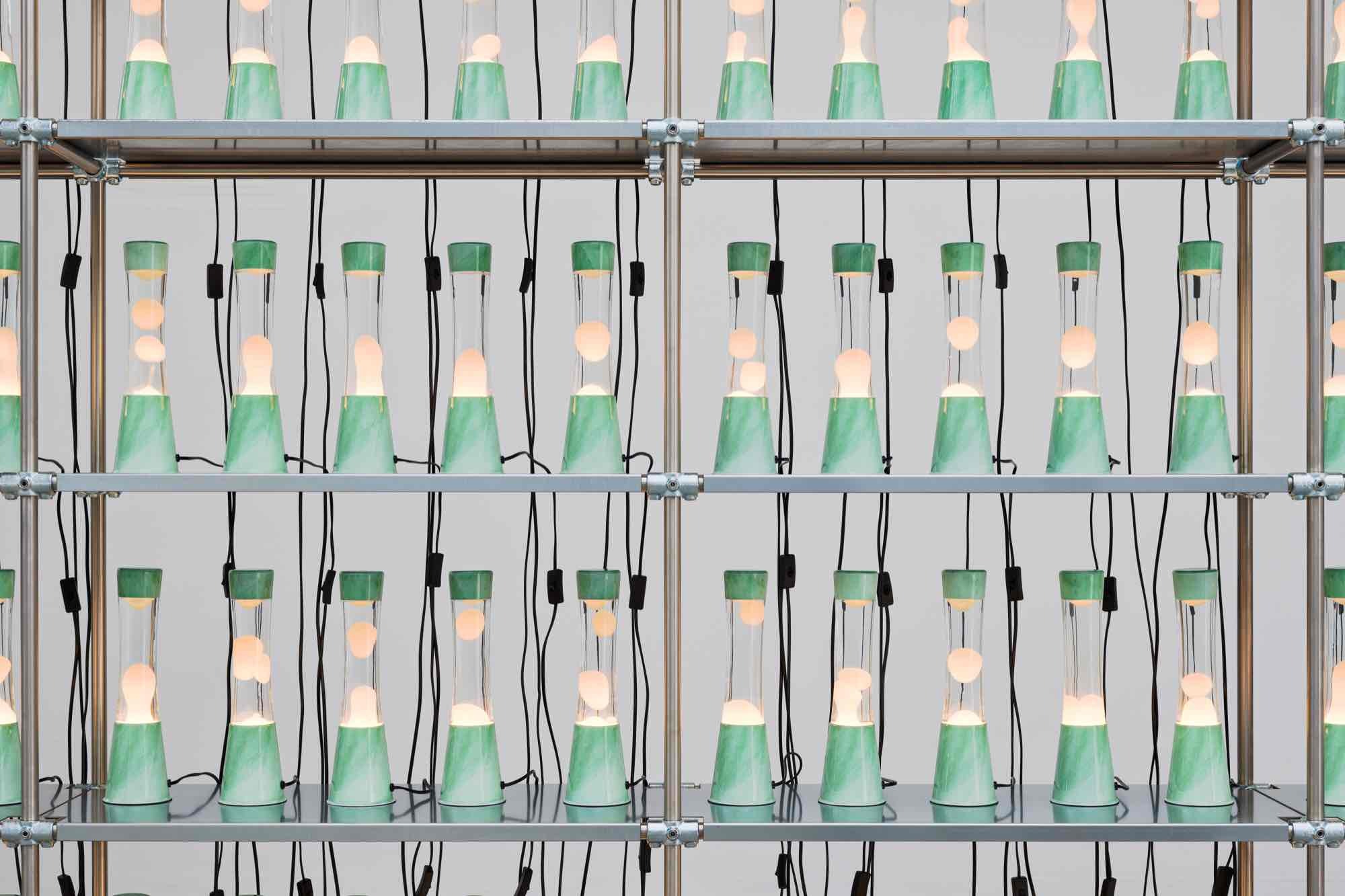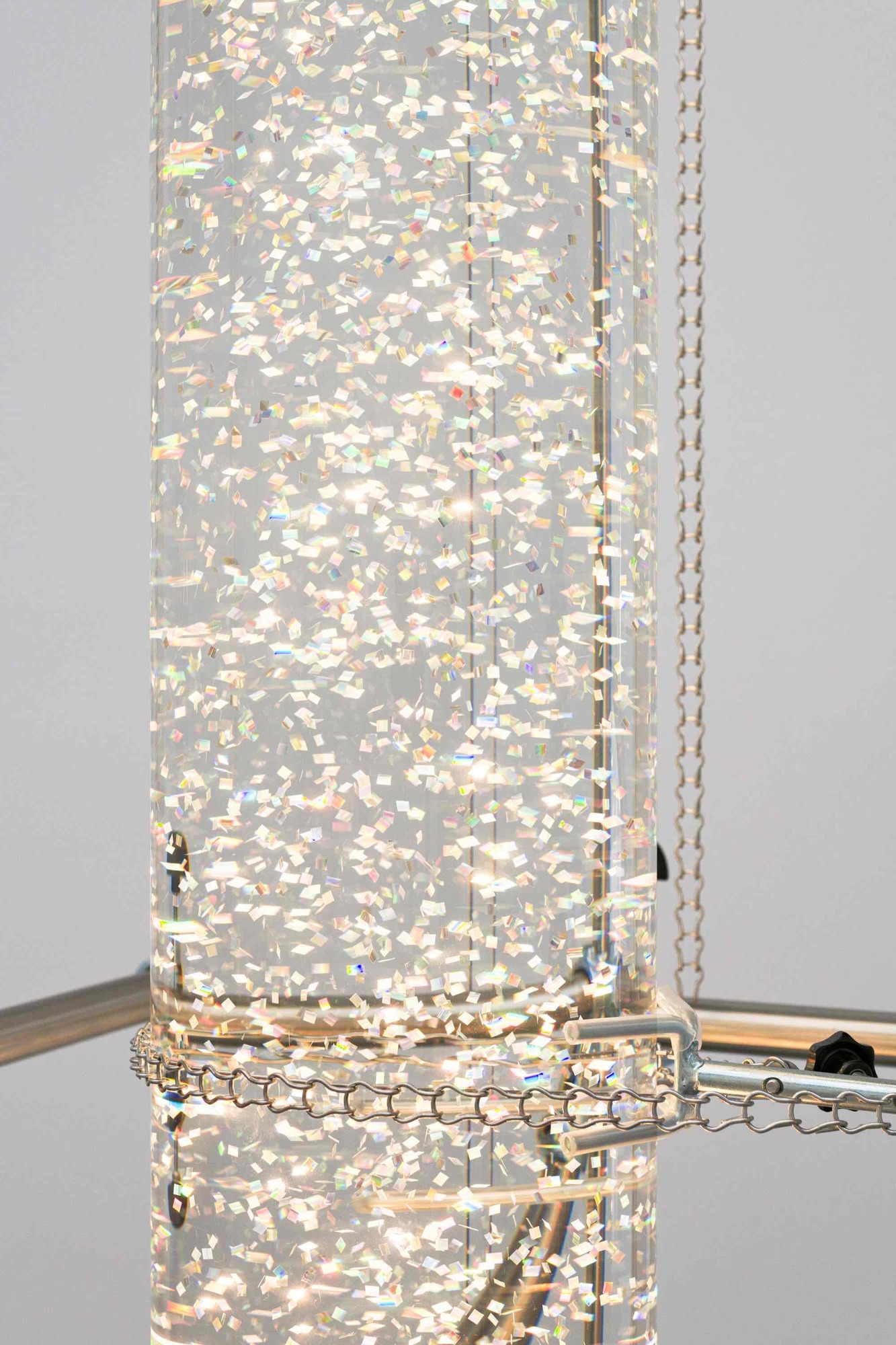Lazar Lyutakov
1 Million Random Numbers
30 Jun - 03 Sep 2023
Many of Lazar Lyutakov’s works appropriate ordinary articles of our modern mass culture and simple industrial products, presenting them in a way that probes their meanings and ambiguities. He carefully selects the objects and adapts and enhances them with targeted interventions in an effort to analyze contemporary conditions of production and forms of consumption, flows of capital and commodities, and aesthetic mass phenomena and to reflect on values, productivity, quality, and utility in a post-capitalist industrialized world.
In 1 Million Random Numbers, the new installation he has developed for the Secession, Lyutakov arranges over a hundred different lava lamps on laboratory framework and stands. With the rising and sinking wax bubbles—enhanced, in some lamps, by glitter particles—each lamp by itself exerts a hypnotizing allure and fascination. The arresting play of lights and colors is constantly changing, lending the exhibition a different cast at each instant and endowing it with an ephemeral quality. Lyutakov then combines the spectacular character of this mise-en-scène with a presentation derived from the real use of lava lamps in information technology that he develops into a sculptural language. The frameworks, which he sourced from a laboratory supplier, make the assemblage look like a scientific arrangement. Corresponding to the modular structure of the exhibition space with its characteristic gridded ceiling, floor, and modular wall system, they also act as a counterpoint with their cool technical aura to the weightless physicality of the amorphous wax bubbles.
The mode of deliberately engendered contradiction is evident moreover in the spectrum of the lamp types the artist has gathered, which encompasses handmade models as well as one-off pieces gleaned from eBay and Chinese mass merchandise. The aesthetic references and historical and political narratives that correlate with this rich assortment and the combination of the lamps with racks range from the counterculture of the 1960s across New Age spirituality to the technological utopia of Silicon Valley and the digital capitalism associated with it.
Invented in 1963 and initially marketed by Crestworth Ltd. under the name Astro Lamp, the lava lamp quickly became a popular interior design and decoration object. Its cult status is due in no small part to the euphoric and hedonistic promise of freedom associated with the psychedelic shapes it produces. The lamp epitomizes the infinity of the unknown—of the vast universe as well as the mysteries of the human mind.
Another aspect of the lava lamp that inspired Lyutakov to make it the central element of his installation was that it has been used since the mid-1990s as a random generator in internet encryption. The work Wall of Entropy is modeled on a similar wall at the network services provider Cloudflare, which uses it to secure 10 percent of global internet traffic. Photographs of the light and color patterns taken at regular intervals serve as seeds for the unpredictable, chaotic, and random element that is indispensable for the implementation of digital encryption processes. In this way, the history of the lava lamp’s significations embodies not only the ideas and values of the counterculture, but always also the contemporary evolution of technological utopianism in the hands of IT corporations and its resulting usurpation by economic interests.
Far from resolving the tensions that result from the confrontation between all these layers of meaning, Lyutakov precisely articulates them and systematically keeps them in suspense. As Stephen Zepke observes in his essay on the exhibition: “Although Lyutakov’s 1 Million Random Numbers can be read as a succinct abbreviation of these rather pessimistic historical and political narratives, the exhibition does not feel like a lament because it offers too much enjoyment. While this may just be the vapid pleasure of contemporary consumption, I see it is a celebration of a chaotic and rebellious element that no longer produces a counterculture, but can never be entirely commodified or captured.”
Curated by Annette Südbeck
In 1 Million Random Numbers, the new installation he has developed for the Secession, Lyutakov arranges over a hundred different lava lamps on laboratory framework and stands. With the rising and sinking wax bubbles—enhanced, in some lamps, by glitter particles—each lamp by itself exerts a hypnotizing allure and fascination. The arresting play of lights and colors is constantly changing, lending the exhibition a different cast at each instant and endowing it with an ephemeral quality. Lyutakov then combines the spectacular character of this mise-en-scène with a presentation derived from the real use of lava lamps in information technology that he develops into a sculptural language. The frameworks, which he sourced from a laboratory supplier, make the assemblage look like a scientific arrangement. Corresponding to the modular structure of the exhibition space with its characteristic gridded ceiling, floor, and modular wall system, they also act as a counterpoint with their cool technical aura to the weightless physicality of the amorphous wax bubbles.
The mode of deliberately engendered contradiction is evident moreover in the spectrum of the lamp types the artist has gathered, which encompasses handmade models as well as one-off pieces gleaned from eBay and Chinese mass merchandise. The aesthetic references and historical and political narratives that correlate with this rich assortment and the combination of the lamps with racks range from the counterculture of the 1960s across New Age spirituality to the technological utopia of Silicon Valley and the digital capitalism associated with it.
Invented in 1963 and initially marketed by Crestworth Ltd. under the name Astro Lamp, the lava lamp quickly became a popular interior design and decoration object. Its cult status is due in no small part to the euphoric and hedonistic promise of freedom associated with the psychedelic shapes it produces. The lamp epitomizes the infinity of the unknown—of the vast universe as well as the mysteries of the human mind.
Another aspect of the lava lamp that inspired Lyutakov to make it the central element of his installation was that it has been used since the mid-1990s as a random generator in internet encryption. The work Wall of Entropy is modeled on a similar wall at the network services provider Cloudflare, which uses it to secure 10 percent of global internet traffic. Photographs of the light and color patterns taken at regular intervals serve as seeds for the unpredictable, chaotic, and random element that is indispensable for the implementation of digital encryption processes. In this way, the history of the lava lamp’s significations embodies not only the ideas and values of the counterculture, but always also the contemporary evolution of technological utopianism in the hands of IT corporations and its resulting usurpation by economic interests.
Far from resolving the tensions that result from the confrontation between all these layers of meaning, Lyutakov precisely articulates them and systematically keeps them in suspense. As Stephen Zepke observes in his essay on the exhibition: “Although Lyutakov’s 1 Million Random Numbers can be read as a succinct abbreviation of these rather pessimistic historical and political narratives, the exhibition does not feel like a lament because it offers too much enjoyment. While this may just be the vapid pleasure of contemporary consumption, I see it is a celebration of a chaotic and rebellious element that no longer produces a counterculture, but can never be entirely commodified or captured.”
Curated by Annette Südbeck










